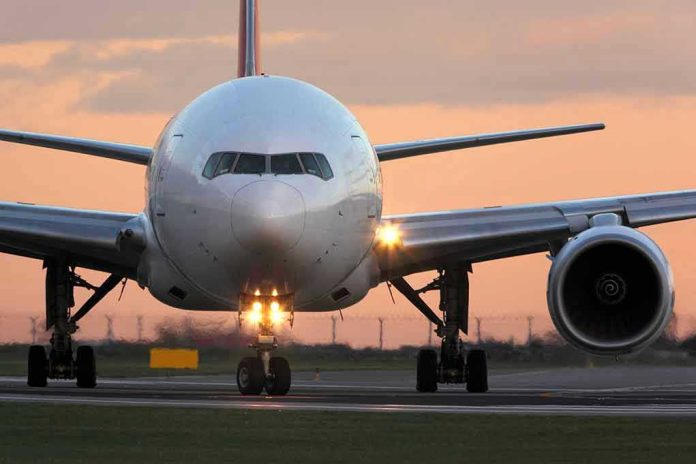
Alaska Airlines, a pillar of American aviation, ground to a complete halt nationwide—not by weather, not by labor, but by a silent, invisible force: a catastrophic technology failure that left thousands stranded and exposed the fragile nerves of modern air travel.
Story Snapshot
- A critical IT outage forced Alaska Airlines to ground all flights across U.S. airports, canceling 229 flights and disrupting both Alaska and Horizon Air operations.
- The outage stemmed from a hardware failure at a data center, echoing a similar incident just months prior and highlighting systemic vulnerabilities in airline IT infrastructure.
- Operations resumed within a day, but the airline warned of ongoing disruptions as it worked to reposition aircraft and crews, with Hawaiian Airlines—recently acquired by Alaska Air Group—unaffected.
- The event reignited debates over the risks of digital dependency in aviation and the consequences of industry consolidation.
- Passengers faced immediate chaos, while experts called for renewed focus on backup systems and infrastructure resilience.
The Day the System Failed
Alaska Airlines’ technology backbone snapped. A hardware failure at a data center cascaded into a total operational shutdown, grounding every Alaska and Horizon Air flight from coast to coast. No takeoffs. No landings. Just a nationwide pause button pressed by an unseen glitch. Passengers found themselves in limbo, airport gates crowded with confusion, and airline staff scrambling for manual workarounds in a system built for seamless digital flow.
This was not a storm, not a strike, not a security scare. It was a failure of the very systems designed to make air travel predictable. The outage lasted hours, but the disruption rippled far longer, as Alaska Airlines canceled flights, delayed others, and warned travelers to brace for further hiccups even after systems came back online. The scale was staggering: a major U.S. carrier, grounded in an instant, by a single point of failure.
History Repeating
This was not Alaska Airlines’ first rodeo with technology demons. Just months earlier, in July 2025, a similar hardware failure at a data center had forced a three-hour grounding. The airline industry, meanwhile, has a growing rap sheet of IT meltdowns—Southwest’s 2022 holiday debacle, Delta’s 2016 system crash—each a reminder that the skies are only as reliable as the servers on the ground. Alaska Airlines, once a beacon of operational consistency, now finds itself in the same spotlight, its reputation for reliability suddenly in question.
The context is critical: airlines have leaned ever harder on digital systems for everything from ticketing to crew scheduling to weight and balance calculations. The more integrated the systems, the greater the risk when one link fails. Alaska’s recent acquisition of Hawaiian Airlines adds another layer of complexity, testing the limits of operational scalability and system redundancy. The outage raises a hard question: Is bigger always better, or does consolidation create new vulnerabilities?
Who Pays the Price?
The immediate victims are the passengers—families missing reunions, business travelers missing meetings, vacationers watching plans evaporate. But the pain spreads. Airport staff juggle stranded travelers, ground crews face overtime and stress, and Alaska Airlines bleeds revenue from canceled flights and compensation claims. The financial hit is real, but the reputational damage may cut deeper. Trust, once lost, is hard to regain.
Alaska Airlines grounds all flights across US airports due to widespread technology issue https://t.co/79uLZFhI1R
— FOX Business (@FoxBusiness) October 24, 2025
The outage also puts pressure on IT vendors and data center operators, whose reliability is now under a microscope. Airlines depend on these third parties, but when things go south, it’s the airline’s name on the departure board and the social media backlash. The power dynamic is clear: airlines hold the brand risk, but their fate is tied to outside tech providers. Passengers, meanwhile, have limited recourse beyond complaints and hope for rebooking—a reminder that in the digital age, the customer is often at the mercy of systems they cannot see or understand.
The Road to Recovery
By Friday, Alaska Airlines had restarted its engines, both literally and figuratively. Flights resumed, but the airline cautioned that normal operations would take time to restore. Aircraft and crews were out of position, schedules were in disarray, and the ripple effects of a single day’s outage would linger for days. The airline urged passengers to check flight status before heading to the airport, a small ask compared to the chaos of the previous 24 hours.
Behind the scenes, the incident triggered a scramble not just to fix the immediate problem, but to prevent a repeat. Industry experts point to the need for robust backup systems, regular stress testing, and a hard look at whether consolidation—while promising economies of scale—also concentrates risk. The FAA, ever-watchful, may now take a closer look at airline IT resilience, adding regulatory pressure to the mix.
Broader Lessons for a Digital Age
Alaska Airlines’ outage is a wake-up call, not just for the airline industry, but for any enterprise that has staked its operations on digital infrastructure. The event exposes a paradox: the very technology that makes modern life efficient also makes it fragile. When systems fail, the impact is immediate, widespread, and deeply personal. For airlines, the stakes are especially high—every minute of downtime means real people, real plans, real dollars on the line.
Experts agree: the solution is not to retreat from technology, but to invest in redundancy, resilience, and transparency. Passengers deserve to know what’s happening, why it’s happening, and what’s being done to fix it. Airlines, for their part, must balance growth and complexity with the need for operational stability. In an age where a single server can strand an entire fleet, preparedness is not a luxury—it’s a necessity.
Sources:
KSL: Alaska Airlines resumes operations after an IT outage grounded its flights for hours
OPB: Alaska Airlines resumes operations after an IT outage grounded its flights for hours






